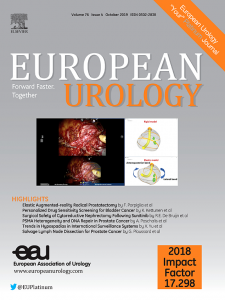Updated Systematic Review and Meta-analysis of Extracorporeal Shock Wave Lithotripsy, Flexible Ureterorenoscopy, and Percutaneous Nephrolithotomy for Lower Pole Renal Stones
IF 25.3
1区 医学
Q1 UROLOGY & NEPHROLOGY
引用次数: 0
Abstract
Lower pole stones (LPSs) frequently cause significant morbidity, necessitating effective intervention strategies. We systematically reviewed the evidence for treatment of LPSs with extracorporeal shock wave lithotripsy (ESWL), flexible ureterorenoscopy (FURS), and percutaneous nephrolithotomy (PCNL) previously in 2015. In this update, we have included 16 new randomised controlled trials plus eight from our original review (24 in total). Despite the increase in available trials, the certainty of evidence remains moderate for stone-free rates (SFRs), underscoring the on-going need for more robust trials in this domain. FURS demonstrated superior efficacy in achieving SFRs to ESWL (risk ratio [RR] 1.19, 95% confidence interval [CI] 1.05, 1.35), although the absolute difference remains modest. ESWL may lead to fewer complications, and FURS could result in more unplanned procedures and retreatments. It remains unclear whether there are differences in quality of life and cost estimates vary depending on the country. PCNL offers a marginal yet statistically significant advantage over FURS in terms of SFRs (RR 1.07, 95% CI 1.01, 1.12), but it is unclear whether there are differences in unplanned procedures, retreatments, or complications, and there was conflicting evidence about health status and return to normal activities. SFRs were superior with PCNL to those with ESWL (RR 1.42 95% CI 1.28, 1.58). Unplanned procedures and retreatments were generally fewer for PCNL, and complications were fewer for ESWL. The cost effectiveness of each modality is highly dependent on the health care system and country-specific economic factors. The overall certainty of the evidence remains unchanged, with only moderate improvements in certain domains.求助全文
约1分钟内获得全文
求助全文
来源期刊

European urology
医学-泌尿学与肾脏学
CiteScore
43.00
自引率
2.60%
发文量
1753
审稿时长
23 days
期刊介绍:
European Urology is a peer-reviewed journal that publishes original articles and reviews on a broad spectrum of urological issues. Covering topics such as oncology, impotence, infertility, pediatrics, lithiasis and endourology, the journal also highlights recent advances in techniques, instrumentation, surgery, and pediatric urology. This comprehensive approach provides readers with an in-depth guide to international developments in urology.
 求助内容:
求助内容: 应助结果提醒方式:
应助结果提醒方式:


